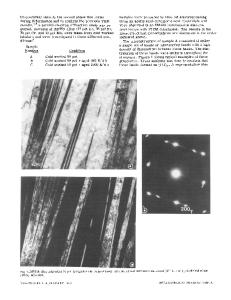The Use of Electron Microscopy and Electron Diffraction in the Study of Phase Transformations
- PDF / 11,613,199 Bytes
- 34 Pages / 414 x 635.4 pts Page_size
- 45 Downloads / 426 Views
THE USE OF ELECTRON MICROSCOPY AND ELECTRON PHASE TRANSFORMATIONS
DIFFRACTION
S. AMELINCKX*'**, G. VAN TENDELOO* AND J. VAN LANDUYT* * University of Antwerp (RUCA) Groenenborgerlaan 171, Belgium; ** Also at S.C.K., B 2400-MOL, Belgium
IN THE STUDY
OF
B 2020-ANTWERP,
INTRODUCTION In recent years a separate branch of electron microscopy, which can conveniently be termed "Solid State Electron Microscopy" has evolved into a discipline of its own, which makes use of a set of techniques such as - diffraction contrast electron microscopy - high resolution transmission electron microscopy - selected area electron diffraction - convergent beam electron diffraction - optical diffraction of high resolution electron micrographs and which allows to provide information on a wide variety of solid state phenomena. With the availability of microscopes with a resolution equal to interatomic distances its field of application has recently been extended greatly. It is the purpose of this paper to indicate to what extent solid state electron microscopy can contribute to our understanding of phase transitions. Diffraction, as well as imaging techniques, can provide information of a geometrical nature, in reciprocal space as well as in direct space. Only those aspects of phase transitions which are reflected in geometrical features are thus accessible to solid state electron microscopy. For some problems the emphasis is on the diffraction pattern, for other problems the image is more informative. For a large number of problems the consecutive use of these two classes of techniques on the same crystal area is required. We shall first describe the observable features, i.e. the defects which are of interest in phase transformations; afterwards we shall discuss the associated contrast effects as well as the effects on the diffraction pattern. Finally we shall illustrate them by means of a few representative examples.
MICROTEXTURES One of the essential features of a phase transition is the change of symmetry that accompanies it. Most frequently the low temperature phase has a lower symmetry than the high temperature phase, i.e. its space group is a subgroup of that of the high temperature phase [I]. As a result of this a single crystal of the high temperature phase breaks up into a number of symmetry related domains. The structures in these domains are related by the symmetry operations which were lost during the phase transition. The orientation variants result from the decrease in point group symmetry; they are separated by "twin" interfaces. With each variant a rotational symmetry operation can be associated, by which this variant is derived from an arbitrarily chosen initial variant. The set of these symmetry operations very often, but not always, forms a pointgroup, which has been called the "variant generating group" [2]. Translation variants are separated by anti-phase boundaries with a displacement vector which corresponds with one of the symmetry translations lost on transformation.
Mat. Res.
Soc. Symp. Proc. Vol.
21 (1984)
Data Loading...











